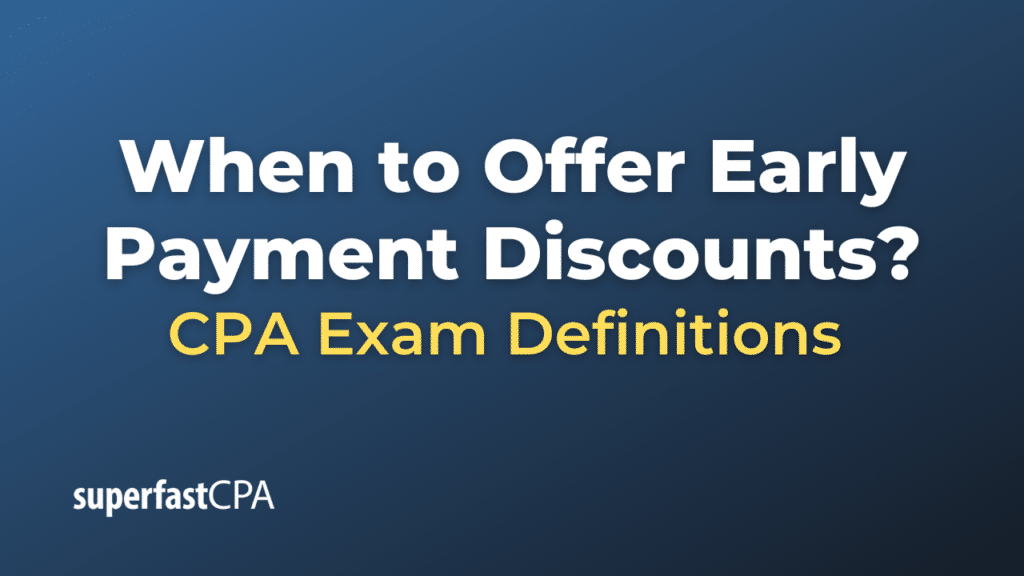When to Offer Early Payment Discounts
Offering early payment discounts can be a strategic decision for businesses that want to improve cash flow, reduce the risk of bad debts, and potentially strengthen relationships with customers. However, it’s not suitable for all businesses or in all situations. Here are some considerations for when to offer early payment discounts:
When to Offer:
- Cash Flow Needs: If your business needs to improve cash flow quickly, offering an early payment discount can encourage customers to pay their invoices sooner.
- High Receivables Turnover: If you have a high volume of accounts receivable and want to turn them into cash more quickly, early payment discounts may be an effective tool.
- Customer Incentives: If you’re trying to win new business or maintain long-term relationships with valuable clients, an early payment discount can serve as an attractive incentive.
- High Profit Margins: If your profit margins are high enough to absorb the cost of the discount, then offering one may make sense.
- Reduced Collection Costs: If the cost of collecting overdue accounts is significant, an early payment discount could reduce these administrative expenses.
- Competitive Differentiation: If you operate in a highly competitive market, offering early payment discounts could differentiate your business from competitors.
- High Credit Risk: If you’re dealing with customers who present a high credit risk, encouraging early payment can mitigate the risk of bad debts.
- Seasonal Businesses: If your business is seasonal and you need to build up cash reserves before a slow period, early payment discounts can be a good strategy.
Things to Consider:
- Profit Impact: Consider the impact on profitability, as the discount you offer will reduce your revenue.
- Cost-Benefit Analysis: Evaluate whether the benefit in cash flow or customer relationship improvement outweighs the cost of offering the discount.
- Terms and Conditions: Be clear about the terms, such as the discount percentage and the time period within which the payment should be made to avail of the discount (e.g., 2/10, net 30).
- Customer Behavior: Understand your customers’ payment behavior. Offering early payment discounts to customers who would pay early anyway could unnecessarily erode your margins.
- Accounting Implications: There may be accounting implications to consider, such as how to record the discount and its impact on revenue recognition.
- Legal and Compliance: Make sure your discount policy complies with legal requirements and industry standards.
Example of When to Offer Early Payment Discounts
Let’s consider a hypothetical scenario involving a small business owner named Emily, who runs a wholesale stationery supply company. Emily has been facing cash flow issues and wants to speed up the collection of accounts receivable.
Scenario:
- Business Needs: Emily needs to build up cash reserves before a slow period in her seasonal business cycle.
- High Profit Margins: Her profit margins are relatively high, which allows her the flexibility to offer discounts without a severe impact on profitability.
- Customer Relationship: She also wants to incentivize her regular clients to make prompt payments, strengthening her business relationship with them.
Early Payment Discount Offer:
Emily decides to offer an early payment discount with the terms “2/10, net 30” on her invoices, meaning that her customers can take a 2% discount if they pay within 10 days; otherwise, the net amount is due within 30 days.
Example Calculation:
Suppose Emily invoices a regular client for $5,000 for a bulk supply of stationery items. With the early payment discount, the client has two options:
- Pay $4,900 within 10 days (2% discount on $5,000 = $100; $5,000 – $100 = $4,900)
- Pay the full invoice amount of $5,000 within 30 days.
Outcome:
- Her client decides to take advantage of the discount and pays the invoice within 10 days, sending a payment of $4,900.
- Emily successfully speeds up the collection of this receivable, improving her cash flow.
- The client is pleased with the discount and is encouraged to continue doing business with Emily’s company.
Accounting Entries:
For Emily, the journal entries would be:
- When invoicing the client:
Debit: Accounts Receivable $5,000
Credit: Sales Revenue $5,000
- When receiving payment within 10 days:
Debit: Cash $4,900
Debit: Sales Discounts $100 (to account for the discount offered)
Credit: Accounts Receivable $5,000
By offering an early payment discount, Emily has successfully improved her cash flow while also incentivizing prompt payment from her clients. She also knows she needs to track how many customers take advantage of the discount and assess the impact on her profit margins over time to make sure this strategy remains beneficial for her business.













